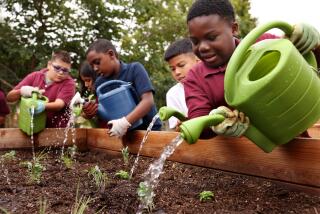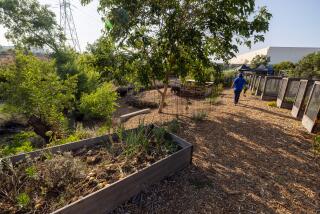Elementary Science
- Share via
Sir Isaac Newton probably would be smiling down at Pam Hutchins’ kindergarten class.
With balls, wooden ramps and other gadgets, the Santa Ana teacher introduced her 4- and 5-year-olds to the basic laws of gravity and velocity on a recent Tuesday.
OK, so maybe Hutchins’ class does not delve deeply into the concepts, but the goal is to tickle these youngsters’ interest in science with interactive lessons, said Hutchins, who teaches at George Washington Elementary School.
“Physical science is really high level for children at this age,” she said. “But this is to get them to start thinking about science.”
She pulled materials from two large blue bins provided by the Arnold and Mabel Beckman Foundation as part of a $14.4-million grant to expand science education in Orange county’s elementary schools. The same grant has put Hutchins in two years of monthly training to learn more about how to teach science.
And with both the science kit and her training, Hutchins launched her students into the study of rudimentary physics.
In small groups, pupils tested how far four balls, varying in size and weight, would roll off a wooden ramp. A fun lesson in momentum: the heavier the ball, the more momentum and the farther it goes.
“If you use hands-on activities, that helps children remember what they’ve learned,” Hutchins said.
In many elementary classrooms, science instruction is avoided. Some instructors believe they don’t have the expertise to teach it well. Others complain that rounding up the curriculum and resources are too much trouble.
“Some teachers are intimidated by science,” Hutchins said. “Gathering the materials alone can take a lot of time.”
But with the donation by the Beckmans, announced last week, science education may be becoming a priority in Orange County schools. In her teacher training, Hutchins has been learning practical and effective ways of inserting science in the classroom.
The grant also provides teachers science kits filled with instructional manuals, student workbooks and props for science experiments to help students tackle topics in chemistry, biology and physics.
And while Orange County works to improve science education, the California Board of Education is expected to approve state science standards in October.
“Kids are naturally curious about science,” said Julia Wan, director of Beckman@Science, the county’s new science program funded by the Beckman grant. “With science, students can touch and feel what they are learning. If we don’t capture that curiosity, then that’s a lost opportunity.”
The box of materials Hutchins was using also showed how elementary science can be taught with the simplest of household objects.
In fact, parents can conduct fun mini-lessons in science around the house and just about everywhere they go with their children, according to a guide published by the North Carolina Museum of Life and Science.
Here are some suggestions from the guide:
* On animals: Watch a spider spin its web; follow a caterpillar as it changes into a butterfly; take your children with you when going to the veterinarian’s office.
* On weather: Look at weather maps; read thermometers; fly a kite in the wind; look for signs of seasonal changes.
* On energy and conservation: Find your electric meter and measure how much electricity your family uses; recycle household materials; rub a balloon on your hair to make static electricity.
* On Earth and space: Observe the moon’s shape; grow and examine salt and sugar crystals; see how shadows change during the day.
* On plants: Plant seeds in a window box, grow mold on bread; examine parts of a flower; sprout lima beans and other edible seeds.
* On physics and chemistry: Bounce light with mirrors; mix and measure ingredients while cooking.
The guide, titled “Sharing Science with Children: A Guide for Parents,” has more suggestions and specific activities geared to different age levels. For a copy, write to Georgiana M. Searles, North Carolina Museum of Life and Science, P.O. Box 15190, Durham, NC 27704.
More to Read
Sign up for Essential California
The most important California stories and recommendations in your inbox every morning.
You may occasionally receive promotional content from the Los Angeles Times.










